Vittorio Matteo Corcos
Vittorio Matteo Corcos (4 October 1859 – 8 November 1933)[1] was an Italian painter, known for his portraits. Many of his genre works depict winsome and finely dressed young men and women, in moments of repose and recreation.
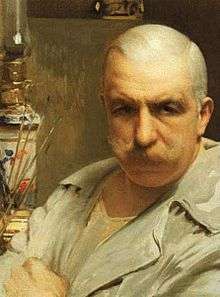
Biography
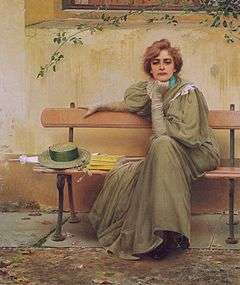
He was born to Jewish parents, Isacco e Giuditta Baquis, in Livorno. He trained at the Academy of Fine Arts of Florence under Enrico Pollastrini. Between 1878 and 1879 he worked under Domenico Morelli in Naples.[2]
He then traveled to Paris where he met Léon Bonnat, and signed a contract with the Goupil & Cie, he was able to supplement his income as a portrait painter with illustrations for magazines. He frequented the circles of Giuseppe De Nittis. Between 1881 and 1886, he frequently exhibited at the Salon.[3]
He returned to Italy in 1886, putatively to join the army, and settled in Florence. He converted to Catholicism and married a widow, Emma Ciabatti. In Florence, he made friends in the intellectual circles, and made portraits of Silvestro Lega, Giosue Carducci, and Pietro Mascagni. After 1900, he wrote for the Florentine Journal Il Marzocco. He also published a short story in the magazine Fanfulla della Domenica titled Mademoiselle Leprince. In 1904, he traveled to Potsdam to paint Emperor William II and other members of the German monarchy. During World War I, his son died in battle in 1916. In the 1920s he joined the Gruppo Labronico along with Plinio Nomellini and Ulvi Liegi.[4]
He also painted portraits of Mussolini (1928); Countess Annina Morosini; Countess Nerina Volpi di Misurata; Carducci, Puccini and Mascagni; Queen Amélie of Portugal, Princess of Orleans;
In 1913, his self-portrait was accepted by the Uffizi museum.[1][5]
He died in Florence in 1933.
Gallery
- Paintings by Vittorio Matteo Corcos
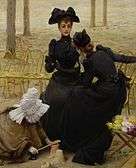 Conversation in the Jardin du Luxembourg
Conversation in the Jardin du Luxembourg In The Garden
In The Garden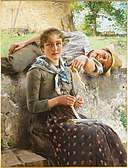 Stella and Piero, 1889
Stella and Piero, 1889 Young Woman with a little dog
Young Woman with a little dog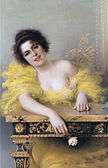 Portrait of a Young Woman
Portrait of a Young Woman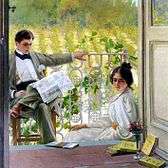 Pomeriggio in terrazza
Pomeriggio in terrazza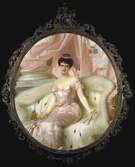 Portrait of Amélia de Orleães Queen of Portugal, 1905
Portrait of Amélia de Orleães Queen of Portugal, 1905
Collections
- Sogni, 1896, Galleria Nazionale d'Arte Moderna, Rome
- Portrait d'Amélie d'Orléans, 1905, National Coach Museum
- Self portrait : Uffizi
Bibliography
- Carlo Sisi : Vittorio Corcos : il fantasma e il fiore : [mostra, Livorno, Museo Civico "G. Fattori", 26 giugno - 7 settembre 1997, Firenze, Galleria d'arte moderna, Palazzo Pitti, 16 settembre-12 ottobre 1997] , Firenze : EDIFIR, 1997, (ISBN 978-88797-0054-2)
- Ilaria Taddei, Fernando Mazzocca, Carlo Sisi: Corcos: i sogni della Belle Époque, Marsilio, 2014 (ISBN 978-88317-1749-6).[6]
References
- Biography from 2014 exhibition.
- Benezit Dictionary of Artists
- The New York Times, article by Roderick Conway Morris A Reassessment of Corcos, Sensuality and Subtlety Intact, Oct. 7, 2014
- Gardens and Ghettos: The Art of Jewish Life in Italy edited by Vivian B. Mann, Jewish Museum (New York, N.Y.), page 332.
- Encyclopedia Treccani; Dizionario Biografico degli Italiani - Volume 28 (1983), entry by Carlo Sisi.
- Ggbooks
External links
| Wikimedia Commons has media related to Vittorio Matteo Corcos. |